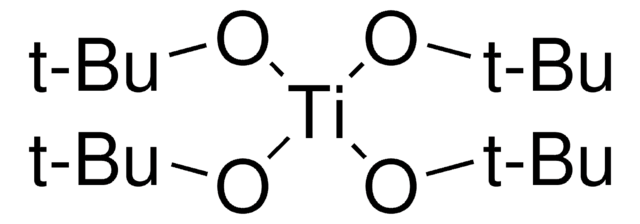205273
Isopropóxido de titanio (IV)
97%
Sinónimos:
TTIP, Ortotitanato de tetraisopropilo
About This Item
Productos recomendados
Nivel de calidad
Ensayo
97%
Formulario
liquid
idoneidad de la reacción
core: titanium
reagent type: catalyst
índice de refracción
n20/D 1.464 (lit.)
bp
232 °C (lit.)
mp
14-17 °C (lit.)
densidad
0.96 g/mL at 20 °C (lit.)
cadena SMILES
CC(C)O[Ti](OC(C)C)(OC(C)C)OC(C)C
InChI
1S/4C3H7O.Ti/c4*1-3(2)4;/h4*3H,1-2H3;/q4*-1;+4
Clave InChI
VXUYXOFXAQZZMF-UHFFFAOYSA-N
¿Está buscando productos similares? Visita Guía de comparación de productos
Categorías relacionadas
Descripción general
Aplicación
Envase
Información legal
Palabra de señalización
Warning
Frases de peligro
Consejos de prudencia
Clasificaciones de peligro
Eye Irrit. 2 - Flam. Liq. 3 - STOT SE 3
Órganos de actuación
Central nervous system
Código de clase de almacenamiento
3 - Flammable liquids
Clase de riesgo para el agua (WGK)
WGK 1
Punto de inflamabilidad (°F)
105.8 °F - Pensky-Martens closed cup
Punto de inflamabilidad (°C)
41 °C - Pensky-Martens closed cup
Equipo de protección personal
Eyeshields, Faceshields, Gloves, type ABEK (EN14387) respirator filter
Elija entre una de las versiones más recientes:
¿Ya tiene este producto?
Encuentre la documentación para los productos que ha comprado recientemente en la Biblioteca de documentos.
Los clientes también vieron
Artículos
Electrospinning technique applications discussed, emphasizing control of nanofibers and assembly into 3D architectures.
Electrospinning technique applications discussed, emphasizing control of nanofibers and assembly into 3D architectures.
Electrospinning technique applications discussed, emphasizing control of nanofibers and assembly into 3D architectures.
Electrospinning technique applications discussed, emphasizing control of nanofibers and assembly into 3D architectures.
Nuestro equipo de científicos tiene experiencia en todas las áreas de investigación: Ciencias de la vida, Ciencia de los materiales, Síntesis química, Cromatografía, Analítica y muchas otras.
Póngase en contacto con el Servicio técnico














